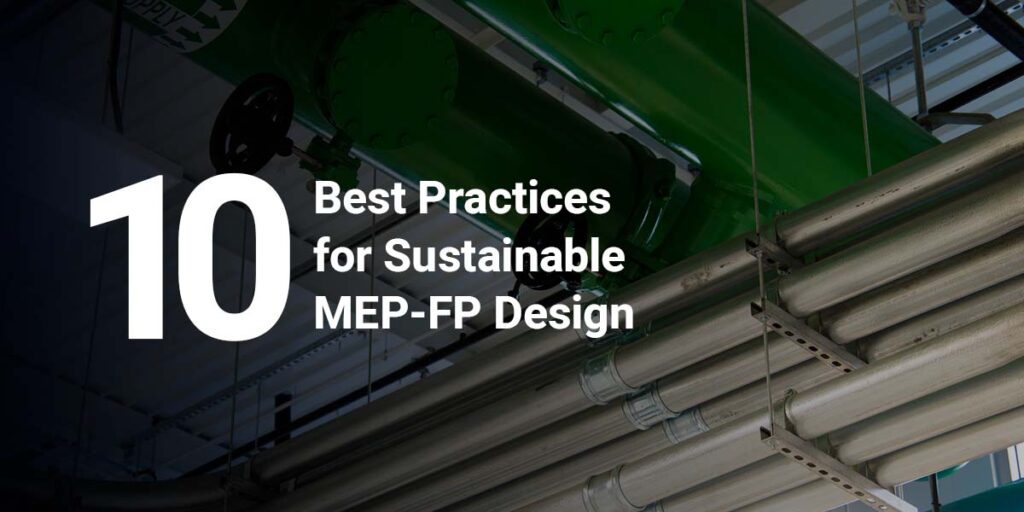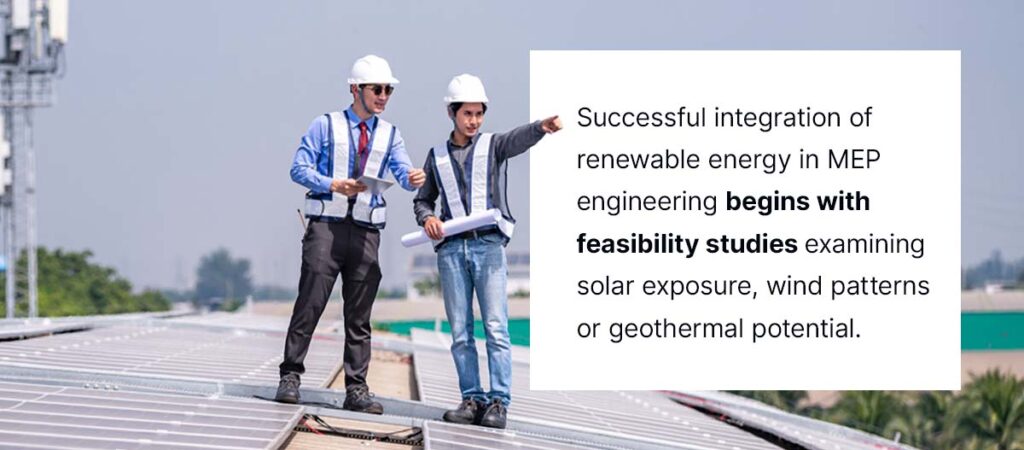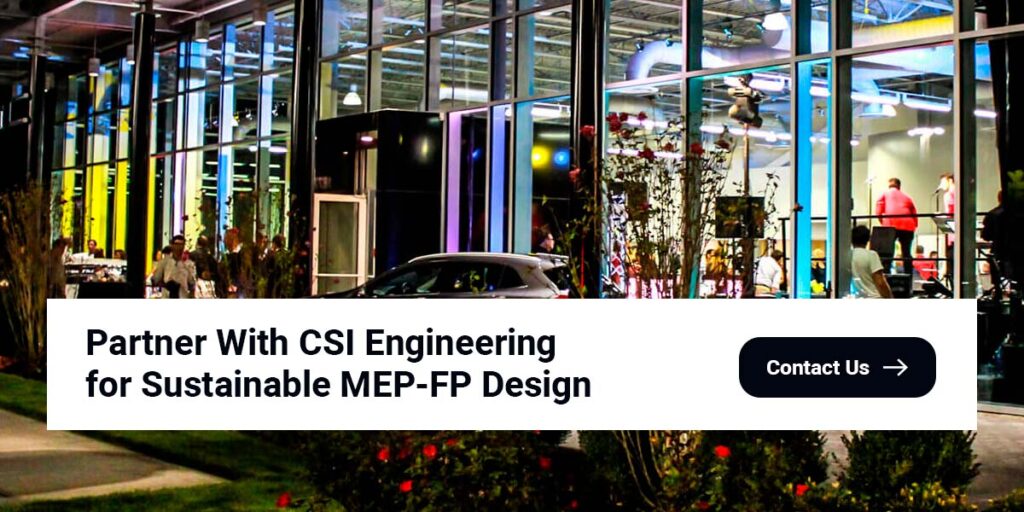


Mechanical, Electrical, Plumbing and Fire Protection (MEP-FP) systems represent the most complex and energy-intensive components of any building. These integrated networks consume substantial resources, drive operational costs and determine indoor environmental conditions throughout a structure’s lifespan.
As regulatory requirements tighten and energy costs escalate, property owners must navigate a sophisticated landscape of efficiency standards, environmental mandates and technological innovations. MEP sustainability has evolved from an optional consideration to an operational necessity.
This comprehensive guide presents 10 proven approaches that transform MEP-FP systems into efficient, resilient assets while delivering measurable returns on investment.
MEP sustainability, also known as green MEP, represents an integrated approach to building systems that prioritizes resource efficiency throughout design, construction and operation. Rather than treating mechanical, electrical, plumbing and fire protection as separate disciplines, sustainable MEP design views these systems as interconnected networks requiring holistic optimization.
This philosophy encompasses energy reduction through:
Sustainable MEP-FP has become essential for commercial properties, educational facilities and historic structures. Rising energy costs, stricter environmental regulations and occupant expectations for healthy indoor environments drive transformation. Green MEP strategies represent smart business decisions that protect ecological resources and financial performance.
Strategic implementation of sustainable MEP design generates substantial returns across environmental, economic and social dimensions. These benefits include:
These benefits compound over time, creating buildings that perform better, cost less to operate and provide superior environments for occupants.
Creating sustainable MEP-FP systems requires integrated planning from project inception. Early collaboration between architects, engineers and building owners ensures systems work together efficiently rather than competing for resources. The following best practices for sustainable MEP design provide a roadmap for achieving exceptional performance:
HVAC systems are the most significant opportunity for energy reduction in most buildings. Strategic HVAC design balances occupant comfort with resource efficiency.
Sustainable MEP design leverages the following:
Implementation success depends on accurate load calculations using ASHRAE procedures. Demand-controlled ventilation adjusts fresh air intake based on actual occupancy, preventing energy waste. Commissioning ensures systems operate as designed, while ongoing monitoring identifies optimization opportunities. Professional HVAC systems design engineering services ensure optimal system selection and integration.
Lighting technology advances create unprecedented opportunities for energy reduction while maintaining occupant satisfaction. Comprehensive electrical systems design engineering ensures efficiency, code compliance and future flexibility.
LED fixtures offer up to 75% energy savings while providing excellent color rendering and dimming. Beyond simple lamp replacement, sustainable lighting design incorporates daylight harvesting, occupancy sensors and programmable controls. Task-specific lighting reduces overall power requirements while improving visual comfort.
Successful implementation requires detailed photometric analysis to ensure appropriate light levels. Layered lighting design combines ambient, task and accent strategies to minimize total wattage. Power quality improvements, including harmonic filtering and power factor correction, reduce electrical losses.
Integrating lighting controls with building automation systems enables sophisticated scheduling and dimming strategies. Additionally, smart electrical distribution design minimizes voltage drop and copper usage.
Water scarcity affects regions nationwide, making conservation essential for responsible building operation. Comprehensive water management reduces consumption while maintaining user satisfaction.
Low-flow fixtures are a great starting point, but comprehensive water management goes further. Sensor-operated faucets, dual-flush toilets and waterless urinals dramatically reduce consumption. Pressure optimization reduces flow rates while maintaining adequate service. Smart water meters identify leaks quickly, preventing waste and damage.
Advanced strategies capture alternative water sources:
Expert plumbing systems design engineering makes implementing these advanced systems seamless, ensuring proper sizing and code compliance.
Material selection impacts environmental footprint and indoor air quality. Thoughtful specification reduces impacts while supporting occupant health.
Sustainable materials and their role in MEP systems extend beyond recycled content. Low-VOC adhesives, sealants and insulation protect occupant health. Locally sourced materials reduce transportation emissions while supporting regional economies. Additionally, modular designs enable disassembly and reuse at renovation or demolition.
Implementation involves establishing clear sustainability criteria during design. Specification documents should prioritize materials with environmental product declarations (EPDs) and health product declarations (HPDs). Supplier vetting ensures materials meet sustainability claims.
On-site renewable energy generation transforms buildings from energy consumers to potential producers. These options include:

Successful integration of renewable energy in MEP engineering begins with feasibility studies examining solar exposure, wind patterns or geothermal potential. Systems sizing must balance initial costs with long-term benefits. Integration with existing electrical infrastructure requires careful coordination. Additionally, energy storage systems maximize self-consumption while providing backup power.
Sophisticated simulation tools optimize design decisions before construction commits resources. Whole-building energy modeling predicts interactions between systems and the building envelope.
Energy modeling software accounts for thermal mass, infiltration and occupancy schedules. Calibrated models use utility data to improve accuracy for existing building retrofits:
Implementation integrates modeling throughout design phases. Architectural decisions are informed by early massing studies, with system sizing relying on detailed load calculations from models. Value engineering uses modeling to evaluate the cost-effectiveness of efficiency measures.
Third-party certification programs provide frameworks for achieving and documenting sustainability. Leadership in Energy and Environmental Design (LEED) remains the most recognized standard, with other programs addressing specific market segments.
LEED emphasizes performance-based credits, rewarding actual efficiency rather than design intent:
Professional LEED consulting services guide credit selection and documentation strategies. Certification success requires early commitment and integrated planning. Documentation throughout design and construction proves compliance, while enhanced commissioning verifies that systems perform as intended.
Sustainable performance extends beyond initial construction, requiring thoughtful design decisions that enable efficient long-term operation and maintenance throughout building life.
Equipment accessibility is a fundamental requirement often overlooked until maintenance becomes difficult and expensive. Sustainable MEP design encompasses accessibility, automation and long-term performance:
Digital tools revolutionize maintenance practices. Computerized maintenance management systems (CMMS) track schedules and history, with predictive analytics identifying impending failures before disruption.
Smart controls orchestrate MEP systems for optimal efficiency while maintaining occupant comfort. Smart building integration includes advanced sequences that optimize start times based on weather forecasts and thermal mass.
It also features demand-controlled ventilation, which adjusts fresh air based on carbon dioxide measurements. Fault detection and diagnostics identify problems automatically, with optimal start/stop algorithms minimizing runtime while ensuring comfort.
Implementation of building automation systems requires thoughtful system architecture. Open protocols ensure interoperability between manufacturers, and cybersecurity measures protect against unauthorized access. Integration with utility programs enables demand response participation, while intuitive interfaces enable effective operator interaction.
Climate change brings extreme weather events and shifting temperature patterns. Building systems must withstand intensifying climate impacts while adapting to evolving technologies. Resilient MEP-FP design anticipates these challenges through robust equipment selection and redundant systems. Adaptable infrastructure accommodates future technology upgrades without major renovations.
To implement resilient and adaptable MEP-FP design, examine local climate projections and natural hazard exposure. Include critical systems that require backup power and redundant equipment to maintain operations during disruptions. Additionally, flexible distribution systems enable easy reconfiguration as space usage changes.

Sustainable MEP design transforms buildings into efficient, healthy, resilient assets that deliver lasting value. CSI Engineering brings over 25 years of experience creating innovative MEP-FP solutions for commercial, institutional and government clients throughout New England. Our specialized engineers collaborate directly with clients from concept through commissioning, ensuring systems meet immediate needs and long-term sustainability goals.
Contact us today to discuss how sustainable MEP-FP design can enhance your next project’s performance and value.